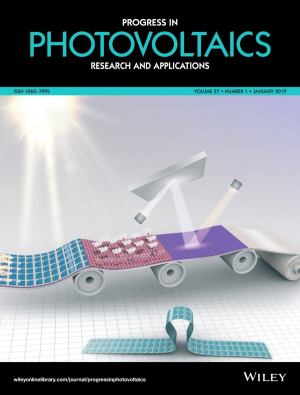Flexible, Low-Cost Solar Cell Device Key to Affordable Energy
The journal Progress in Photovoltaics: Research and Applications featured an article on the collaborative work of two UH Cullen College of Engineering research groups on its cover in January.
The article, titled “High efficiency flexible III/V photovoltaic solar cells based on single crystal-like thin films directly grown on metallic tapes,” is about the design and development of highly-efficient, low-cost flexible solar cell devices that can adapt to different environments and uses.
“The overarching goal of the research is to develop flexible and low-cost, yet high-efficiency photovoltaic device – something that generates electricity by exposing material to light – using high-quality solar cell materials on inexpensive metal tape through a continuous deposition process,” said Jae-Hyun Ryou, associate professor of mechanical engineering.
There has been much interest in developing thin-film solar cells because they are lightweight and flexible. Landing on the cover was the result of a breakthrough.
“We demonstrated – for the first time – a working solar cell device based on our research,” Ryou said. The new development provides a pathway toward inexpensive high performance gallium arsenide or GaAs thin-film photovoltaics.
The project is funded by the U.S. Department of Energy’s SunShot Initiative, which seeks to make solar energy and electricity affordable for American consumers.
The first authors on the paper are Sara Pouladi, a materials science and engineering doctoral student working with Ryou; and Monika Rathi, a research scientist working with the Selva Research Group led by Venkat Selvamanickam, M.D. Anderson Chair Professor of mechanical engineering.
Pouladi designed, modeled and fabricated the flexible thin-film GaAs solar cells based on a new single-crystal-like GaAs material grown on metal tapes by Rathi.
“We demonstrated that we can provide high-efficiency, thin-film GaAs solar cells on low-cost metal foils, bypassing conventional expensive and brittle wafer substrates while offering flexibility and scalability,” Pouladi said. “These flexible solar cells can be curved and bent to fit selected placement area wherever electricity is needed – from your rooftop to your backpack in a remote area.”
Other contributing authors on the paper are: Davendra Khatiwada, Mojtaba Asadirad, Seung Kyu Oh, Pavel Dutta, Yao Yao, Ying Gao, Sicong Sun, Yongkuan Li, Shahab Shervin, Keon-Hwa Lee, Selvamanickam and Ryou.
Progress in Photovoltaics, published by Wiley, is a prestigious forum for reporting advances in the rapidly developing field of photovoltaic technology.
To read the article, please visit: https://onlinelibrary.wiley.com/toc/1099159x/2019/27/1
